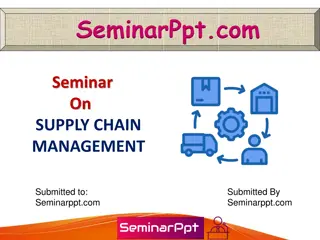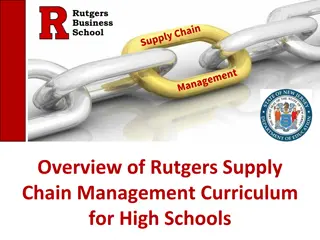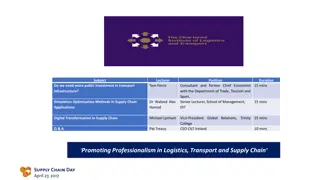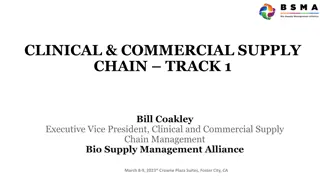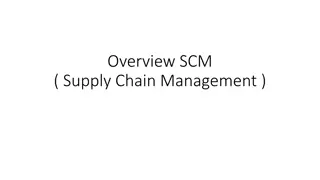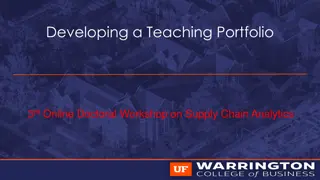Understanding Supply Chain Management Principles
This content delves into Supply Chain Management (SCM) principles, covering essential functions like demand planning, supply management, warehousing, inventory management, manufacturing, transportation, and customer service. It outlines the basics and strategies of modern supply chains, emphasizing the integral role SCM plays in achieving organizational strategic goals.
Download Presentation

Please find below an Image/Link to download the presentation.
The content on the website is provided AS IS for your information and personal use only. It may not be sold, licensed, or shared on other websites without obtaining consent from the author. Download presentation by click this link. If you encounter any issues during the download, it is possible that the publisher has removed the file from their server.
E N D
Presentation Transcript
Common Learning Blocks Learning Block 1 Supply Chain Management Principles
Abstract This document, Common Learning Blocks (CLBs), prefaces each of the eight LINCS track certifications and is intended to provide an overview of SCM and the relationship of each of the functions, or tracks, in a supply chain. The supply chain functions included herein are demand planning, supply management and procurement, warehousing operations, inventory management, manufacturing and service operations, transportation operations, and customer service. The goal of the content in this Common Learning Blocks document is to prepare students to understand the principles of SCM and the sequence of those principles.
Course Agenda 1. Supply Chain Management Principles 2. Demand Planning 3. Supply Management and Procurement 4. Warehousing Operations 5. Inventory Management 6. Manufacturing and Service Operations 7. Transportation Operations 8. Customer Service Operations 3
Supply Chain Management Principles Learning Block 1
Learning Block Agenda 1. Supply Chain Basics 2. Supply Chain Strategy 3. Modern Supply Chains
Description Defines the major functions that are necessary for operational supply chain. Defines the linkage of the functions that form the chain. How that chain is linked with process to form the basis for the management of the supply chain. 6
Learning Objectives Discuss the function in a supply chain. Define Supply Chain Management Explain how supply chains must be integral to an organization's strategic goals.
Unit 1: Supply Chain Basics What is a Supply Chain? A supply chain is a system of people, processes, and technology involved in moving and processing resources and services from raw materials to the end user.
Unit 1: Supply Chain Basics Functions of Supply Chain: Demand Planning Supply Management and Procurement Inventory Management Warehousing Operations Manufacturing and Service Operations Transportation Operations Customer Service Operation
Unit 1: Supply Chain Basics Supply chain management takes into consideration all activities involved in confirming that products from its raw material stage are turned into finished products and delivered to customers. These include: Sourcing of raw material and parts Manufacturing and assembling Warehousing and controlling inventory Entering and managing orders Finishing, customizing, and packaging
Unit 1: Supply Chain Basics Supply chain management activities (cont.): Distributing across all channels Delivering to final customers Managing relationships with suppliers Managing relationships with customers Maintaining information systems necessary to help monitor above activities
Unit 2: Supply Chain Strategy Supply chains should be designed to strategically fit with competitive strategies. Understanding customers and the current supply chain capabilities is important when determining if certain supply chains will be able to support the corporate strategies. The business plan, which includes the competitive strategy, drives the demand and supply plan, which, in turn, drives the supply chain as it seeks to fill customer orders
Unit 3: Modern Supply Chain Competition (Past) Collaboration (Present) Intense competition in industries Supplier development Supplier design involvement Growing companies were capturing more international market share using different strategies Long term supplier Strategic cost management Rapid increases in technology and products with shorter product life cycles
Supply Chain Principle Supply chain management has many systems to help control and monitor the business. The industry trend is to incorporate as many as possible into an integrated (real time, information sharing) Enterprise Resource Planning (ERP). ERP Process:
Practice Questions 1. The levels of suppliers within a supply chain are called: a. Ranks b. Supports c. Tiers d. Services 2. For companies to be competitive, suppliers should be considered: a. Teammates b. Adversaries c. Unreliable d. Unnecessary
Practice Questions 3. A supply chain can best be described as: a. A network of many individual functions b. One or two functions working together c. Negotiating with suppliers d. Choosing the best warehouse strategy 4. Supply Chain Management can be described as a(n): a. Comprehensive approach to the management of the entire flow of individual functions b. Method to increase sales and market share c. Process to create adversarial relationships with suppliers d. Innovative process for choosing carrier modes
Practice Questions 5. The process for customers to return defective products is called: a. Backwards logistics b. Reverse logistics c. Forward logistics d. Domestic logistics





